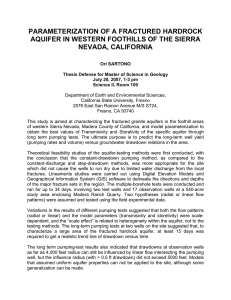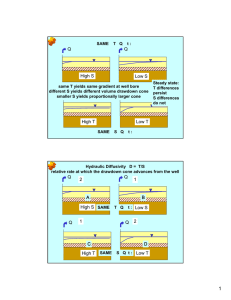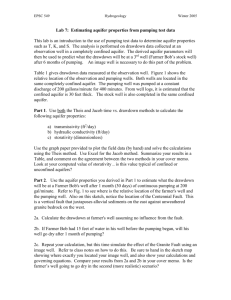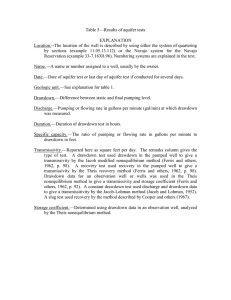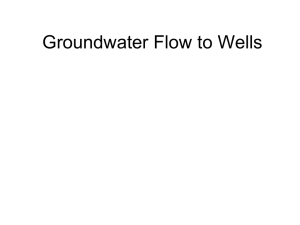Document 14092149
advertisement
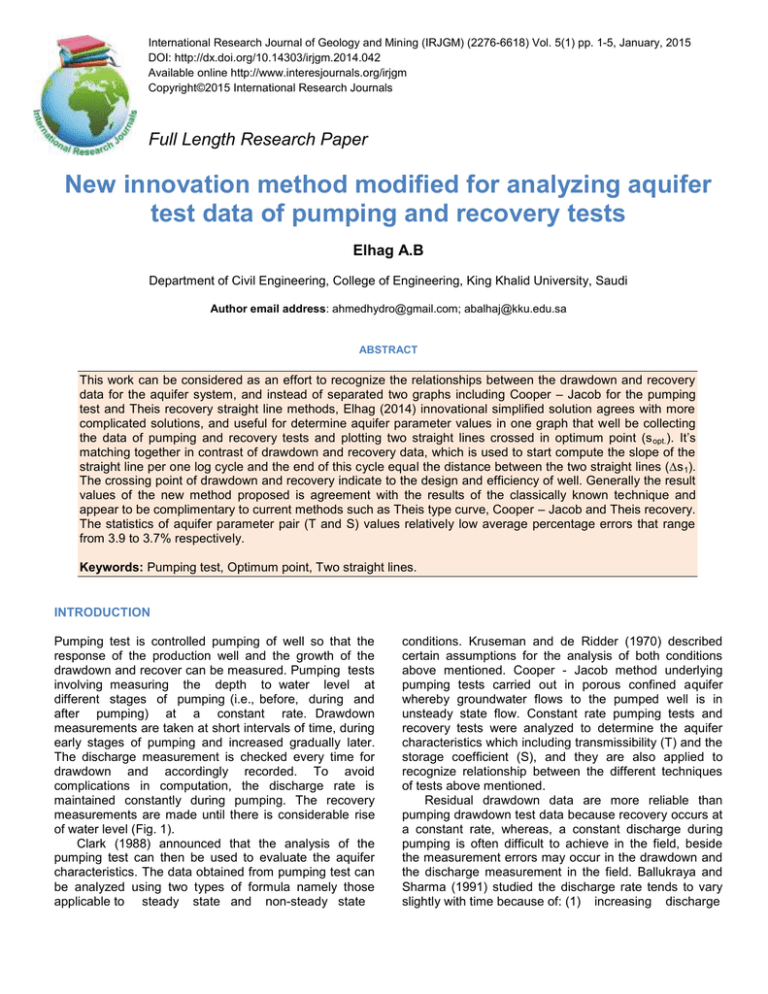
International Research Journal of Geology and Mining (IRJGM) (2276-6618) Vol. 5(1) pp. 1-5, January, 2015 DOI: http://dx.doi.org/10.14303/irjgm.2014.042 Available online http://www.interesjournals.org/irjgm Copyright©2015 International Research Journals Full Length Research Paper New innovation method modified for analyzing aquifer test data of pumping and recovery tests Elhag A.B Department of Civil Engineering, College of Engineering, King Khalid University, Saudi Author email address: ahmedhydro@gmail.com; abalhaj@kku.edu.sa ABSTRACT This work can be considered as an effort to recognize the relationships between the drawdown and recovery data for the aquifer system, and instead of separated two graphs including Cooper – Jacob for the pumping test and Theis recovery straight line methods, Elhag (2014) innovational simplified solution agrees with more complicated solutions, and useful for determine aquifer parameter values in one graph that well be collecting the data of pumping and recovery tests and plotting two straight lines crossed in optimum point (s opt.). It’s matching together in contrast of drawdown and recovery data, which is used to start compute the slope of the straight line per one log cycle and the end of this cycle equal the distance between the two straight lines (∆s 1). The crossing point of drawdown and recovery indicate to the design and efficiency of well. Generally the result values of the new method proposed is agreement with the results of the classically known technique and appear to be complimentary to current methods such as Theis type curve, Cooper – Jacob and Theis recovery. The statistics of aquifer parameter pair (T and S) values relatively low average percentage errors that range from 3.9 to 3.7% respectively. Keywords: Pumping test, Optimum point, Two straight lines. INTRODUCTION Pumping test is controlled pumping of well so that the response of the production well and the growth of the drawdown and recover can be measured. Pumping tests involving measuring the depth to water level at different stages of pumping (i.e., before, during and after pumping) at a constant rate. Drawdown measurements are taken at short intervals of time, during early stages of pumping and increased gradually later. The discharge measurement is checked every time for drawdown and accordingly recorded. To avoid complications in computation, the discharge rate is maintained constantly during pumping. The recovery measurements are made until there is considerable rise of water level (Fig. 1). Clark (1988) announced that the analysis of the pumping test can then be used to evaluate the aquifer characteristics. The data obtained from pumping test can be analyzed using two types of formula namely those applicable to steady state and non-steady state conditions. Kruseman and de Ridder (1970) described certain assumptions for the analysis of both conditions above mentioned. Cooper - Jacob method underlying pumping tests carried out in porous confined aquifer whereby groundwater flows to the pumped well is in unsteady state flow. Constant rate pumping tests and recovery tests were analyzed to determine the aquifer characteristics which including transmissibility (T) and the storage coefficient (S), and they are also applied to recognize relationship between the different techniques of tests above mentioned. Residual drawdown data are more reliable than pumping drawdown test data because recovery occurs at a constant rate, whereas, a constant discharge during pumping is often difficult to achieve in the field, beside the measurement errors may occur in the drawdown and the discharge measurement in the field. Ballukraya and Sharma (1991) studied the discharge rate tends to vary slightly with time because of: (1) increasing discharge 2 Int. Res. J. Geol. Min. Figure1. Schematic presentation of a drawdown – recovery curve (Modified after Elhag, 2014). head, and (2) voltage fluctuations in electric power supply to the pump motor. The second problem can be overcome with voltage stabilizer but these are not always available. Variations due to increasing discharge head, caused by continuous lowering of water levels, are difficult to control in most cases. These reasons lead to study and patent new method useful for solving the problems of drawdown and recovery tests in one graphic. OBJECTIVES AND METHODOLOGY The objectives of this paper are to obtain the relationships between drawdown and recovery tests, and to describe a new method by which aquifer parameters can be computed at each data point on a time drawdown and rise straight line. The analysis of recovery test data is based on the superposition principle on Theis (1935). Applying this principle, we assume that if a well is pumped for a known period of time and then shut down, the drawdown thereafter well be identically the same as if the discharge had been continued and a hypothetical recharge well with the same flow were superposed on the discharging well at the instant the discharge is shut down. The procedure of new method has been proposed to evaluate the properties of the confined aquifer. The analysis of pump test data has been made using both the Cooper – Jacob straight line and Theis recovery graphic method is matching analysis for the determination of aquifer parameters. A semi-logarithmic graph of values of scattered drawdown and residual drawdown data are often interpreted as describing two straight lines from different directions. The procedure for the application of the Elhag method to the determination and finding parameters of confined aquifer outlined as follows: Plot the field measurements on semi-logarithmic coordinate paper in which the drawdown (s) is plotted along the linear y - axis scale and the time (t) since pumping started is plotted along the logarithmic x axis scale. Plot the field measurements on semi-logarithmic coordinate paper in which the residual drawdown (s′) is plotted along the linear y - axis scale and the recovery time (t′) since pumping stopped is plotted along the logarithmic x - axis scale for the same scale of the above mentioned. Corresponding the two papers and the coordinate axes are kept in parallel for the checked matching point called optimum point (sopt.). Briefly in one paper plot the data for a well on semilogarithmic coordinate paper in which the drawdown and residual drawdown in linear scale and the time since pumping started and recovery time since pumping stopped is in logarithmic scale and checked the matching point in one stage. Fitting for the converted and opposed directions of the two straight lines which passing throw the scatted points. Individually determine the slope of the straight line per one log cycle each of one drawdown test (∆s) and recovery test (∆s′), which are starting at the optimum point (sopt.). Elhag 3 Figure2. Drawdown test method for solution of the non-equilibrium equation (A) Theis method (B) Cooper – Jacob method (modified after Internet: Chapter three groundwater flow to wells) Figure3. Recovery test method for solution of the non-equilibrium equation (modified after Internet: Chapter three groundwater flow to wells) Determine the distance between the two straight lines (∆s1) at the end of the slope of the two straight lines per one log cycle, which is equal twice the (∆s) or (∆s′). Extend the straight line of the drawdown test only until it intercepts the time axis where, (s) equal zero and after that read the value of ( ). ∆s1= the distance between the two straight lines at the ended of the per one log cycle. S= Coefficient of storage. = time value in days of the intercept of the straight line portion of the drawdown (extended toward the starting time) and the zero drawdown line. r= distance in feet from the discharging well. The computation of the aquifer parameters (T and S) can be performed in the following two formulas (1 and 2) as follows: RESULTS AND DISCUSSION Where: Q= pumping rate in gpm. T= Coefficient of transmissibility. A large number of analytical methods are available for analyzing aquifer pumping test data such as Cooper – Jacob, 1946, Chow, 1952 and Theis, 1935. These methods are the best agreement with the average aquifer parameter estimates from this method. To illustrate the validity of the proposed method, a well penetrated a confined aquifer is pumped at a uniform rate of 1218gpm. Drawdown (s) during the pumping period (t) is measured in an observation well 100ft away (Fig. 2). The pump was shut down after 800minutes; thereafter, measurements of residual drawdown (s′) and recovery time (t′) (Fig. 3). The 2 Int. Res. J. Geol. Min. Table1. Confined aquifer parameter by different methods Method Elhag Theis type curve Cooper – Jacob Theis recovery 2 T (m /d) 1223.0 1106.0 1144.0 1144.0 Average error S -4 2.1x10 -4 2.0x10 -4 1.9x10 - T error % 5.0 3.3 3.3 S error % 2.4 5.0 - 3.9 3.7 Figure4. Elhag method for solution of the non-equilibrium equation aquifer parameters including transmissibility and storage coefficient values obtained by the new technique patented by Elhag method for plotting the pumping test against the equivalent recovery test data in semi-log paper (Fig. 4). The results of the new method were compared by the other methods which are obtained in (Figs. 2 and 3) The results of applying the Elhag method found that 2 transmissibility equal 1223.4m /d and the storativity about -4 2.1x10 (Table 1).This example shows the effectiveness of the Elhag procedure and it's obvious that the relative small errors in the aquifer parameters with respect to the Elhag solution for compares with the various other methods to confined aquifer test data including Theis type curve, Cooper – Jacob straight line and Theis recovery method results (Figs. 2 and 3). The percent of error results for the pair of (T and S) is relatively differences and range between 3.3 to 5.0% and 2.4 to 5.0% respectively (Table 1). The different methods above mentioned yield a fairly range of parameter values for the same aquifer test, but these differences are within the practically acceptable ranges. The changes in values for the Elhag and other methods of the aquifer parameter that might refer to the differences procedure methods can be identified and scientific researchers applied methods, these issues are one of the negative pumping tests. This method is useful for evaluation the state of well, as well as, the crossing in optimum point (sopt.) before or at the five minutes of drawdown and recovery tests that means the well is the good designing and efficiency, but the crossing effected after the five minutes, which indicated to the poor designing and efficiency of well. Depending mainly on the above mentioned the well is poor designed and efficiency, because the crossing point is event at the ten minutes (Fig. 4). CONCLUSION This paper carried out simple and easy method has been developed to determine the aquifer properties (transmissibility and storativity) from pumping and recovery tests at the same time. Elhag (2014) has patented new method of correlation the data obtained from pumping and recovery tests, the new modified semilog method suggested the plot field data respectively, as the maximum drawdown (s) and residual drawdown during recovery (s′) versus log the time since pumping started (t) and time since pumping stopped (t′).The plot should be two straight lines at different direction from Elhag 5 which transmissibility and storage coefficient calculated quickly from the one graph. REFERENCES Ballukraya PN, Sharma KK (1991). Estimation of storativity from recovery data. Groundwater. 29(4): 495. Clark L (1988). Field Guide to Water Wells and Boreholes. New York: Halsted Press. Chow VT (1952). On the determination of transmissivity and storage coefficients from pumping test data. Transactions, Am. Geophys Union. 33: 397 - 404. Cooper HH, Jacob CE (1946). A Generalized graphical method for evaluating formation constant and summarizing well-field history. Trans. Am. Geophys. Union. 27(4). Elhag AB (2014). New methods of analysis and evaluation of pumping tests data for groundwater wells. 1: 20 – 35. Kruseman GP, de Ridder NA (1970). Analysis and Evaluation of Pumping Test Data, Intl. for Land Reclamation and Improvement, Bulletin 11, Wageningen. Theis CV (1935). The relation between the lowering of the piezometric surface and the rate and duration of discharge of a well using groundwater storage, Trans. of Am. Geophys. Union 16: 519-524. How to cite this article: Elhag A.B (2015). New innovation method modified for analyzing aquifer test data of pumping and recovery tests. Int. Res. J. Geol. Min. 5(1):1-5

